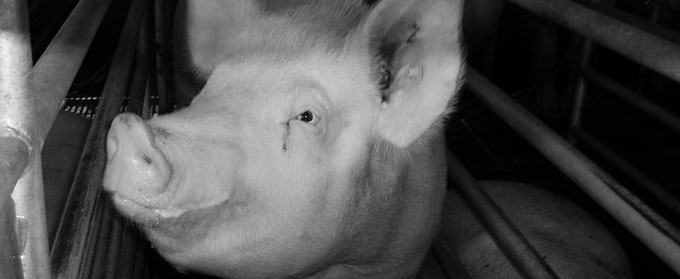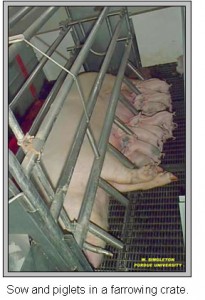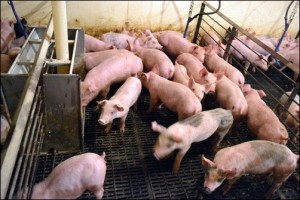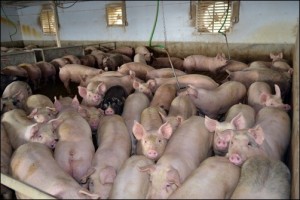Quick Facts
- Factory systems, also known as CAFOs (Concentrated Animal Feeding Operations) began to take hold in the 1960s, and have increasingly replaced small pig farms
- CAFOs containing more than 5,000 pigs comprised 88% of the pig crop in 2008
- December 2012 United States inventory counted 66.3 million hogs and pigs (USDA)
- Nearly 111 million pigs were slaughtered in 2011, while about 80 million were slaughtered in 1990, an increase of about 31 million pigs slaughtered annually over the past 20 years
Life as a Pig in a Factory Farm
Part 1: Birth and Piglethood
Sows are impregnated and kept for about sixteen weeks in a gestation crate, which is typically a narrow stall that allows no room for movement to allow “better control” over the sows by producers. About a week before the sow is due, she is moved into a farrowing stall to give birth. Like in the gestation crate, she can only stand up or lie down, but has no room to turn around or walk. Once the piglets are born, they have access to their mother’s milk through the bars of the crate. During this time, they receive daily injections of antibiotics, their tails are removed, and males are castrated.
Once piglets have been weaned, they are taken to growing buildings to fatten up for slaughter. The sow endures the same process for the rest of her life.
Part 2: Nursery
Newly weaned pigs are brought to nursery facilities, which have a regulated temperature and ventilation controls to ensure the young pigs’ survival. As this photo reveals, metal bars and metal slatted or concrete floors are the typical structure of a nursing pen. The slatted flooring allows feces to fall through the floor, but does not allow for the spreading of straw, denying pigs the ability to forage, a natural behavior. Forcing pigs to constantly stand on metal or concrete flooring can cause foot lesions leading to lameness.
Lack of social and environmental stimulation leads to several problems, such as tail/ear biting. This stereotypy can result from hunger, boredom, or the drive to forage. While it often begins with sucking or chewing, it often escalates into aggressive behavior and can cause serious harm to a pig. Injury and infection often follow and occasionally leads to more cannibalistic behavior. Studies have found that providing enrichments, such as straw or other rooting substrate, can largely reduce biting behavior.
Once pigs have grown to about 50 lbs, they’re transferred to the finishing unit.
Part 3: The Finishing Farm
In the 22 weeks between pigs’ arrival at the finishing farm and their transport to slaughter, pigs grow from 50 lbs to about 260 lbs. According the the Humane Society, the average amount of space for finishing pigs is 0.7 m². Pigs continue to exhibit aggressive and stereotyped behavior due to stress, boredom, and lack of space.
Parts 4 and 5: Transport and Slaughter. These aspects of intensive farming are beyond the scope of my research, but I recommend Slaughterhouse by Gail Eisnitz if you are interested (and have a strong stomach).
Warning: The videos below contain extremely graphic footage of animal abuse that may be upsetting to some viewers.

“…since hogs are very social animals, the people who own and manage hog confinement units must find employees willing to commit their lives to working peaceably with very stubborn animals whose productivity depends in part on the attitudes of those caring for them…the people in hog management have always been important, but in confinement pork production they become essential.”
-Jim Braun, Pigs, Profits, and Rural Communities
Low wages, overwork, poor training, and desensitization often lead to abuse and mistreatment of pigs in intensive farms.




